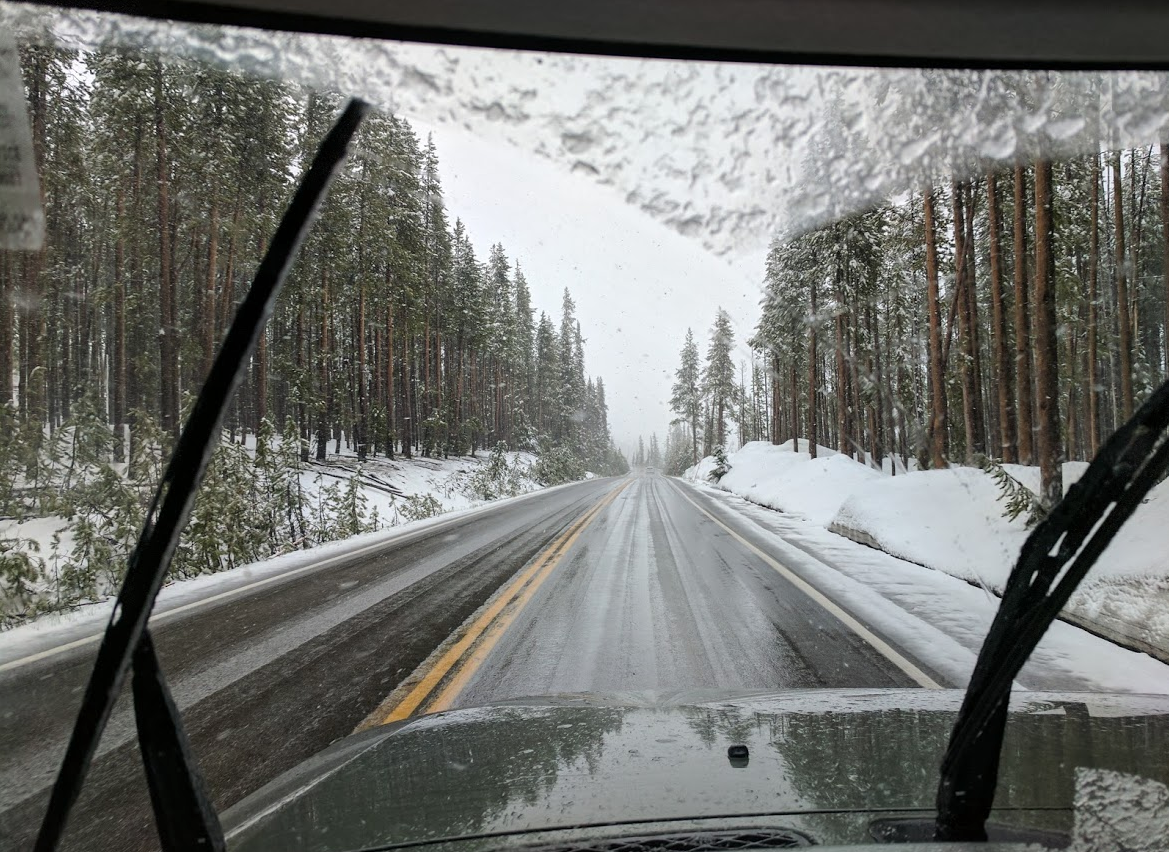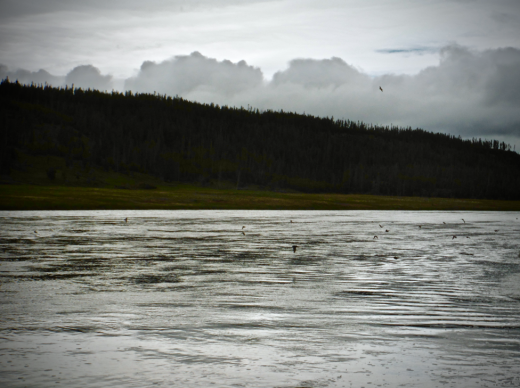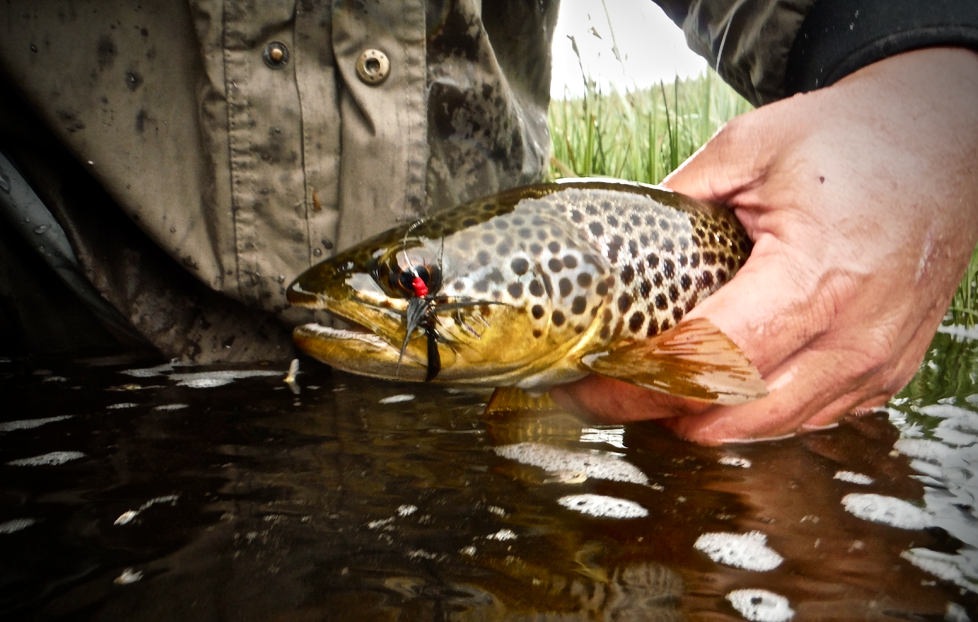By Chris Hunt
The thermometer on my dash read a cold 33 degrees. The calendar claimed it was June 13. Sadly, both were accurate.
Welcome to Yellowstone.
As I topped Craig Pass heading north, snowbanks still lined the Grand Loop Road, and more was falling. My wiper blades could keep the the white stuff off most of the windshield, but snow collected in the spaces the blades couldn’t reach, and every so often, a soft glob of slush would slide down the glass, obscuring my views of Yellowstone as it struggled to change seasons.
The road was slushy during this spring storm, and visitors from warmer climes were parked on the roadside, sporting confused looks on their faces. A busload of Asian visitors frolicked in a snow berm and little kids from Florida ran around the pull-off at the Continental Divide with their faces to the heavens, mouths wide open, catching fat, almost-summer snowflakes on their tongues.

It was painful to see more snow after what can only be described as an epic winter in the region. It drowned my mood a bit—I’ve been ready for summer for months now. Ready for sunshine. Dry flies. Wading sandals. Cold PBR. You know, summer.
I’d come up from Jackson Lake, where my daughter is working for the season, hoping to hit the Firehole on the “scenic route” back to Idaho Falls. It’s prime time on this storied Yellowstone National Park river—when the weather warms in a couple of weeks, the geothermally influenced river will warm up, too, and its fish will hover near coldwater spring seeps and wait out the summer in a state of stubborn sluggishness, or they’ll retreat into smaller tributaries where the water is colder. But now, with air temperatures in the 30s and 40s, the Firehole fishes really well.
And just about everybody knows it, too.
But that’s OK. While it’s certainly possible (imminently possible if the desire is there) to get away from the crowds and fish the Yellowstone backcountry, fishing the Firehole has become something of a social endeavor. No, you won’t be squeezed like you would be on, say, the Salmon River in upstate New York. But you likely won’t be able to fish the river all day without seeing, at the very least, a handful of other anglers. It is what it is, and either you fish the river when it’s prime, or you just don’t fish the river.
As I headed north and down in elevation, the snowbanks got thinner and the park’s spring greenery began to dominate the landscape. Near Upper Geyser Basin where Old Faithful blows her top every 90 minute or so, endless short-grass meadows sported lush, rain-and snow-spurred growth, and winter-weary bison wandered and grazed within feet of road, seemingly oblivious to the throngs of tourists standing alarmingly close (those of us who live here call this Darwin Season—the silliest of visitors are those who wander with a few feet of these tolerant, but unpredictable, creatures in order to get a selfie and a new Facebook profile photo, only to be soundly trampled and find themselves returning to consciousness in a Jackson, Bozeman or Idaho Falls hospital).
I took the Fountain Flat Drive off to the west of the Grand Loop Road—at the south end of the parking lot, a hiking/biking trail wanders off the beaten path a bit, and, even during the best weeks of the season, a determined angler can find a bit of solitude after a short walk.
But I never made it to the parking lot. As I looked down at the river from a perch just above, I saw noses. Fat, Firehole River brown trout noses. An epic Blue-winged Olive hatch was under way, and it was happening right here, under my nose. I looked upriver. An angler was plying a tailout about 200 yards away. Downriver. I could see a fisherman off in the distance. This stretch of water, loaded with rising browns and likely a few rainbows, was all mine.
I geared up and walked just a few steps down the slope to river and realized within seconds that I was at a steep disadvantage. There were so many natural mayflies on the water—thousands and thousands—that my little size 20 BWO didn’t stand a chance. I made a couple of casts along feeding lanes where I’d seen big noses coming up, and watched with frustration as respectable browns sipped naturals within inches of my offering.
To Hell with this.
I tied on a wet fly, cast it across the river and on the first swing, a fat Firehole brown made a grab. I brought the fish to hand—maybe 14 inches or so, a very nice brown for this river—and snapped a couple of quick photos. I let the fish swim back to its feeding lane and stood to make another cast.

But I never did. I looked out over the Firehole, and watched as the swallows dove just over the river’s surface, swiping the baetis as they started to take flight. The fish continued to rise as the flies matted together on the surface waiting for their wings to dry. Hundreds of fish. Hundreds of birds. Thousands upon thousands of flies.
I reeled my line tight and stepped out of the river.
Yes, I’d seen snow one last excruciating time. But without it, I wouldn’t have witnessed this—a slice of national park perfection. As I sat on the bumper of my rig and slid my waders off, I kept an eye on the river. Browns and rainbows kept nosing the surface. The swallows kept dancing in the fading evening light.
It was beautiful. It was my reward.
Chris Hunt is the national editorial director of Trout Media. He lives and works in Idaho Falls, Idaho.



